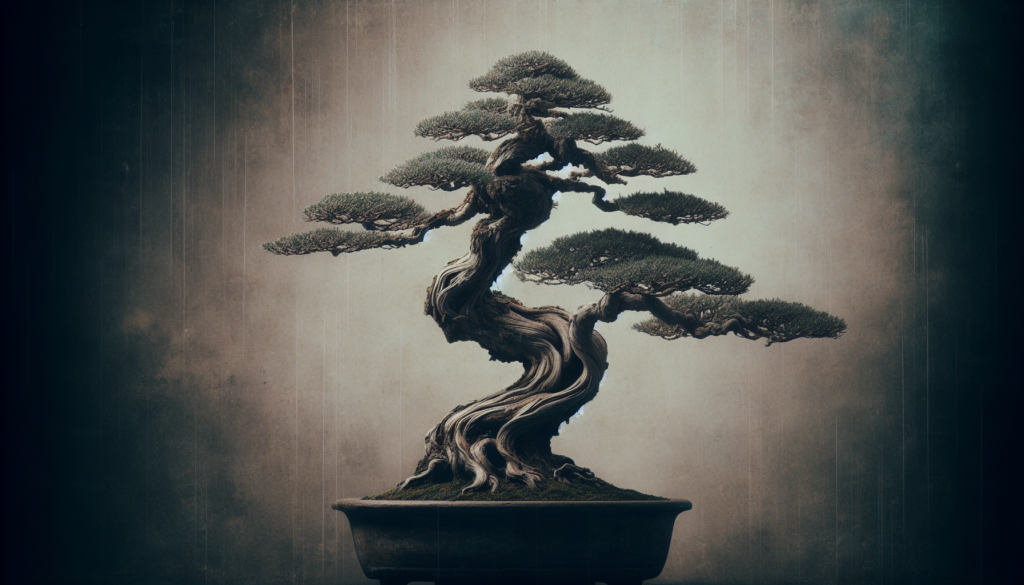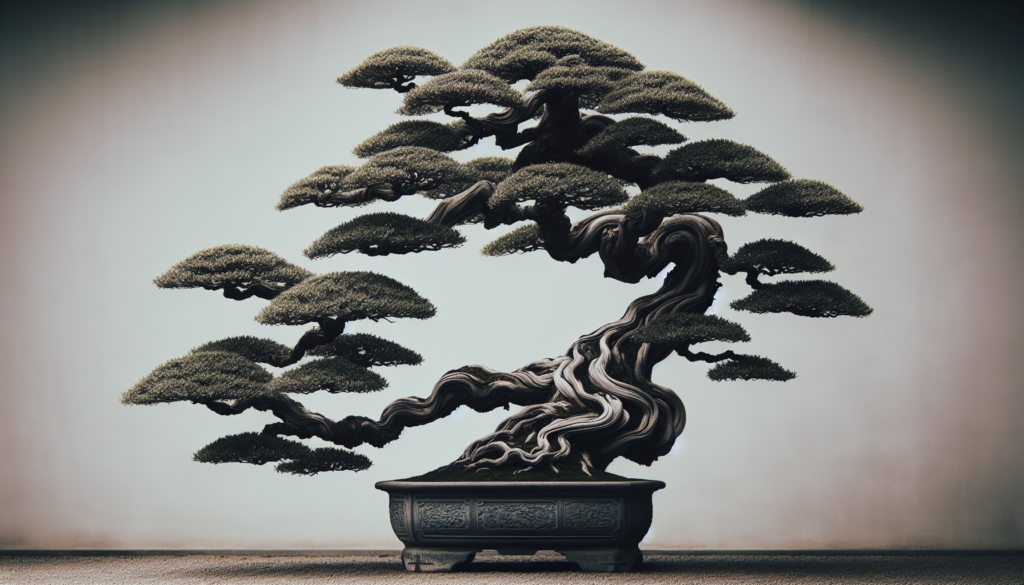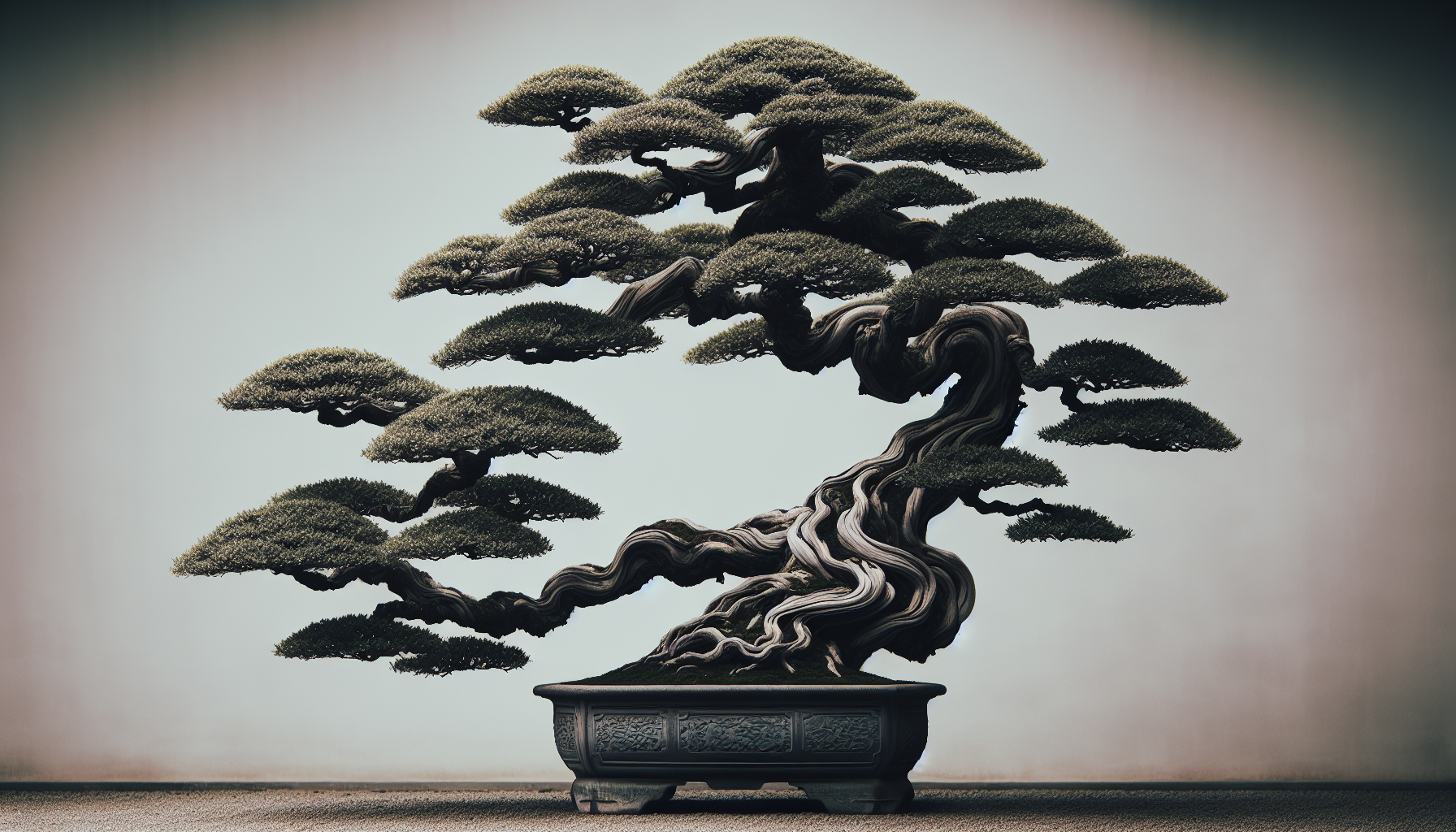In this article, you will discover a truly captivating world of bonsai trees that have beautifully withstood the test of time. These miniature masterpieces, cultivated with skilled care and dedication, have become iconic symbols of patience, artistry, and harmony with nature. From ancient trees that have witnessed centuries of history to meticulously designed gardens, we will delve into the journey of these bonsai wonders and explore the inspiration they offer to all who encounter them. Embark on a journey of discovery as we explore the world of famous bonsai trees and gardens that continue to inspire generations.
The Art and History of Bonsai Trees
Bonsai trees are renowned for their beauty and elegance, but their fascinating history is just as captivating. The art of bonsai originated in Japan, with its roots stretching back over a thousand years. It has since evolved into a beloved form of artistic expression cherished by people all around the world.
Origin of Bonsai in Japan
The art of bonsai first took root in Japan during the Heian period (794-1185). It was heavily influenced by Chinese culture, particularly the practice of growing miniature landscapes in containers. However, the Japanese quickly put their own unique spin on this art form, creating bonsai as we know it today.
Bonsai in Ancient Art and Literature
Throughout Japanese history, bonsai has been cherished as a symbol of harmony, patience, and contemplation. In ancient art and literature, bonsai trees often represented the beauty and tranquility of nature. Many famous Japanese paintings and poems featured bonsai as a central theme, further cementing its place in Japanese culture.
Evolution of Bonsai Styles Over the Centuries
Over the centuries, bonsai styles have evolved and transformed. From the early formal upright and slanting styles to the more intricate windswept and cascade styles, each design tells a unique story. Bonsai artists continuously push the boundaries of creativity, experimenting with new techniques and styles while honoring the traditions that have been passed down through generations.
Famous Historical Bonsai Trees
Some bonsai trees have gained legendary status due to their historical significance and remarkable stories. Let’s explore a few of these famous specimens.
The Yamaki Pine: A Hiroshima Survivor
One of the most iconic bonsai trees in history is the Yamaki Pine, which miraculously survived the atomic bombing of Hiroshima in 1945. Despite being just a few miles away from the epicenter of the explosion, this ancient tree managed to endure the devastation. Today, it serves as a symbol of hope, resilience, and the enduring power of nature.
The 1000-year-old Ficus Bonsai of Italy
Tucked away in a monastery in Italy is a venerable ficus bonsai that has stood the test of time. Estimated to be over a thousand years old, this magnificent tree has witnessed countless historical events and generations of caretakers. Its gnarled branches and intricate root system tell a story of strength, survival, and the beauty that comes with age.
Shogun Tokugawa’s Bonsai: A Token of Power
During the Edo period (1603-1868), bonsai trees were not only admired for their beauty but also used as symbols of power and status. Shogun Tokugawa Iemitsu, the third shogun of the Tokugawa dynasty, was an avid bonsai enthusiast. He commissioned the creation of several remarkable bonsai specimens, which were displayed in his palace gardens as a testament to his authority and wealth.

Cherished Bonsai Trees in Public Collections
Numerous public collections around the world are dedicated to preserving and showcasing the beauty of bonsai. These collections serve as hubs for enthusiasts and provide valuable educational resources for anyone interested in this ancient art form.
The National Bonsai Museum in Washington DC
Located within the United States National Arboretum, the National Bonsai Museum houses one of the most extensive collections of bonsai trees outside of Japan. Visitors can marvel at the diverse range of species and styles on display, gaining a deeper appreciation for the artistry and skill required to create these living masterpieces.
Omiya Bonsai Art Museum in Japan
Situated in the heart of Saitama City, the Omiya Bonsai Art Museum offers a comprehensive exploration of bonsai’s history and cultural significance. The museum boasts an impressive collection of bonsai from various periods and features interactive exhibits to engage visitors of all ages.
Shanghai Botanical Garden in China
The Shanghai Botanical Garden is not only a haven for nature enthusiasts but also houses a remarkable bonsai garden. Here, visitors can wander through serene pathways and admire an array of bonsai specimens, each carefully tended to maintain their beauty and authenticity.
Unusual Bonsai Specimens
While bonsai trees are typically known for their miniature size, there are some specimens that push the boundaries of what is considered traditional. These unusual bonsai specimens captivate viewers with their unique features and innovative approaches.
The Floating Bonsai Trees of Hoshinchu
Hoshinchu, a Japanese company, created a groundbreaking technique that gives the illusion of floating bonsai trees. Using magnetic levitation, these extraordinary bonsai trees hover above their pots, creating a mesmerizing display of natural beauty defying gravity. This innovative approach breathes new life into the art form while keeping its essence intact.
The Sacred Sukina Bonsai in Ise City
Nestled within the grounds of the Ise Grand Shrine in Ise City, Japan, the sacred Sukina Bonsai takes center stage. This ancient bonsai has been cared for by generations of Shinto priests for over five centuries, making it an invaluable part of Japan’s spiritual and cultural heritage.
The Oldest Juniper Bonsai in Mansei-en
In the serene garden of Mansei-en, a bonsai nursery in Japan, resides the oldest known juniper bonsai tree in the world. Estimated to be over 1,000 years old, this venerable tree serves as a living testament to the longevity and enduring beauty of bonsai.

Bonsai Trees in Popular Culture
Bonsai trees have captured the imagination of people around the world and have become an integral part of popular culture. They have made appearances in various forms of media, providing inspiration and adding a touch of elegance to films, television shows, art, literature, and poetry.
Bonsai in Films and Television
From classic movies like “The Karate Kid” to the critically acclaimed series “Breaking Bad,” bonsai trees have graced the silver screen and small screen alike. These appearances often highlight the artistry and peaceful nature associated with bonsai, serving as a visual metaphor for character development or symbolic representation of concepts such as growth and patience.
Bonsai and Contemporary Art
Bonsai’s influence extends beyond the realm of traditional art forms. Many contemporary artists incorporate bonsai trees into their works, creating stunning installations and sculptures that challenge traditional perceptions of space, nature, and time. These artistic interpretations breathe new life into bonsai, blurring the line between art and horticulture.
Bonsai in Literature and Poetry
Bonsai trees have long captured the imagination of writers and poets, inspiring them to pen beautiful verses and stories. From ancient Japanese haikus to modern-day novels, bonsai often serves as a symbolic representation of life’s complexities, the passage of time, and the delicate balance between humanity and nature.
The Lifecycle of a Bonsai Tree
Understanding the lifecycle of a bonsai tree is essential for anyone looking to embark on this rewarding journey. From seed to bonsai, each stage requires careful attention and skilled techniques to ensure the tree’s health and beauty.
From Seed to Bonsai: The Journey of Growth
The journey of a bonsai tree begins with the planting of a tiny seed. With proper care and nurturing, the seed germinates and develops into a seedling. Over time, the young tree undergoes various stages of growth, requiring regular repotting and shaping to train its branches and roots into the desired form.
Pruning and Shaping: The Art of Bonsai Creation
One of the most crucial aspects of bonsai cultivation is pruning and shaping. By carefully trimming and training the tree’s branches and foliage, bonsai artists can bring out its unique character and create visually stunning compositions. Pruning encourages new growth, while wiring and bending techniques allow for the creation of intricate and graceful bonsai styles.
Preservation and Longevity of Bonsai Trees
Bonsai trees are not immortal; however, with proper care and regular maintenance, they can live for hundreds of years. Regular watering, fertilizing, and protecting the tree from extreme weather conditions are essential for its preservation. Bonsai masters meticulously monitor the health and vitality of their trees, ensuring they thrive for generations to come.
Caring for Your Bonsai: A Test of Patience
Owning a bonsai tree is a testament to one’s patience and dedication. Proper care is vital to maintaining the tree’s health and ensuring its long-term beauty. Let’s explore some essential aspects of bonsai care.
Proper Watering Techniques
Watering is perhaps the most critical aspect of bonsai care. The frequency and amount of water required depend on factors such as the size of the tree, the type of soil used, and the climate. It’s important to strike the right balance – not too much to drown the tree’s roots, but not too little to leave it thirsty.
Best Feeding Practices
To thrive, bonsai trees require proper nutrition. Fertilizers specially formulated for bonsai provide the necessary nutrients, aiding in healthy growth and vibrant foliage. Ensuring the right balance of nitrogen, phosphorus, and potassium is crucial, with the dosage varying depending on the tree’s species and current needs.
Sunlight and Temperature Requirements
Providing the right amount of sunlight is essential for the overall health of a bonsai tree. Most bonsai species prefer bright, indirect light, while some thrive in full sun. Understanding the needs of your particular tree and placing it in the appropriate location will help it flourish. Additionally, ensuring the tree is protected from extreme temperatures is crucial, as sudden shifts can harm its delicate structure.
Reviving the Aesthetic Value of Aged Bonsai Trees
Weathered and aged bonsai trees possess a unique aesthetic value that cannot be replicated. The patina acquired over years of growth adds character and depth, making these trees highly sought-after by collectors and enthusiasts.
The Beauty of Weathered and Worn Bonsai Trees
Just as wrinkles and gray hair lend beauty to aged individuals, the signs of wear on bonsai trees give them a distinct charm. Moss-covered branches, gnarled trunks, and delicate scars tell stories of resilience, endurance, and the passage of time. These weathered bonsai trees become living works of art that evoke awe and admiration.
The Significance of Yose-ue in Aged Bonsai
Yose-ue, or the art of multiple tree arrangements, often plays a significant role in enhancing the aesthetic value of aged bonsai trees. By skillfully combining multiple trees of varying ages and sizes, bonsai artists create visually captivating compositions. These arrangements not only showcase the individual beauty of each tree but also celebrate the harmony and balance that can be achieved through thoughtful design.
The Appeal of Shari and Jin on Elder Bonsai
Shari and Jin are techniques used in bonsai to mimic the natural appearance of deadwood and enhance the overall aesthetic. Elder bonsai trees particularly benefit from these techniques, as the addition of exposed wood adds character and highlights the tree’s age and history. Shari involves the removal of bark to expose the wood, while Jin refers to the creation of deadwood branches that give the tree a sense of drama and age.
Bonsai Artists and Their Inspirations
The art of bonsai has been shaped by the creativity and expertise of numerous masters throughout history. Let’s explore some notable bonsai artists and the inspiration behind their timeless creations.
Notable Bonsai Masters of Japan
Japan is home to many legendary bonsai masters who have dedicated their lives to perfecting this art form. From the influential master Kobayashi Mansei to the innovative Kimura Masahiko, their meticulous techniques and artistic visions have left an indelible mark on the world of bonsai.
Western Influence in the World of Bonsai
While bonsai has deep roots in Japanese culture, the art form has also gained popularity and flourished in the West. Western bonsai artists bring their unique perspectives and techniques to the craft, blending traditional Japanese styles with their own artistic sensibilities. This fusion of cultures has led to exciting new developments, expanding the horizons of bonsai as a global art form.
Inspiring Themes and Stories Behind Bonsai Creations
Behind every bonsai creation lies a story, inspiration, or meaningful theme. Bonsai artists often draw inspiration from their surroundings, personal experiences, or cultural traditions. The themes can range from capturing the essence of a particular landscape to symbolizing the resilience of nature or even expressing deep emotions. These stories add depth and significance to each bonsai creation, inviting viewers to connect with the art on a profound level.
The Future of Bonsai: Innovations and Trends
As with any art form, bonsai continues to evolve and adapt to the changing times. Let’s explore some of the exciting innovations and trends that are shaping the future of bonsai.
The Rising Popularity of Indoor Bonsai
With the increasing popularity of urban living and limited outdoor spaces, indoor bonsai has gained significant traction. Miniature varieties and species that thrive in indoor conditions allow enthusiasts to enjoy the art of bonsai in their homes, offices, or apartments. Indoor bonsai brings nature’s beauty indoors while providing a means for individuals to connect with the natural world in an urban setting.
The Fusion of Bonsai with Terrariums
The fusion of bonsai with terrariums has introduced a new dimension to this ancient art form. Terrariums, or mini-enclosed gardens, provide a controlled environment in which bonsai trees can thrive. The combination of lush greenery, glass enclosures, and intricate bonsai designs creates captivating visual displays that capture the imagination and bring a touch of nature indoors.
The Sustainability Issues in the Bonsai Trade
As the demand for bonsai continues to grow, ecological sustainability has become a pressing concern. The sourcing of rare and exotic trees, especially from their natural habitats, can harm delicate ecosystems and threaten biodiversity. Responsible bonsai enthusiasts and growers are working towards sustainable practices, such as propagating bonsai from seeds or cuttings, choosing native species, and supporting ethical trade practices. These efforts aim to ensure the conservation of both the art form and the natural environment.
In conclusion, bonsai trees embody the beauty, patience, and artistic ingenuity of countless generations. From their ancient origins in Japan to their blossoming popularity worldwide, bonsai has captivated the hearts and imaginations of people from all walks of life. Whether admiring famous historical specimens, caring for your own bonsai tree, or immersing yourself in the world of bonsai-inspired art and culture, the art and history of bonsai offer endless inspiration and a boundless connection to the natural world.








